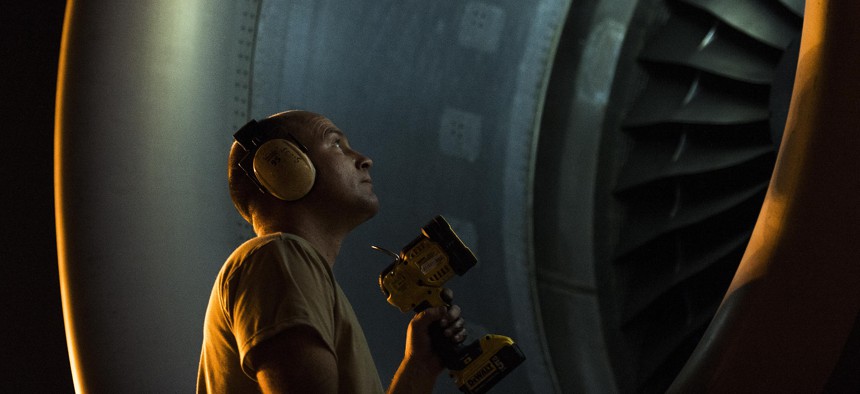
Tech. Sgt. Jonathan Carr, a crew chief with the 62nd Aircraft Maintenance Squadron, Joint Base Lewis-McChord, Wash., checks the engine of a C-17 Globemaster III during Exercise Mobility Guardian at Joint Base Lewis-McChord, Wash., Aug. 6, 2017. U.S. Air Force / Tech. Sgt. Nathan Lipscomb
Defense Firms to Air Force: Want Your Planes’ Data? Pay Up
It may be years before Air Force leaders can scrounge up the funds to turn on diagnostic gear they already own.
The U.S. Air Force wants computers to predict when its cargo planes and tankers are going to break. Some of its planes even have the necessary equipment installed — but service leaders can’t turn it on unless they fork out more money to manufacturers.
That’s because even though the Air Force owns the planes, the rights to the diagnostic information they produce is controlled by manufacturers Boeing and Lockheed Martin and engine makers Pratt & Whitney and General Electric.
“I want to own the data,” Gen. Carlton “Dewey” Everhart, head of Air Mobility Command, said Tuesday during a press conference at an Air Force Association-sponsored conference in the Washington, D.C., suburbs.
“Lockheed, Boeing, [and] everybody else, have a say-so in that,” the general said. “It’s just I want to be a shared partner with them.”
Everhart — who oversees more than 1,200 cargo planes and tankers — said some airlines are already using this kind of predictive maintenance technology, which is built into many new commercial aircraft. It’s installed on some Air Force planes as well‚ including the C-130 and C-17 airlifters and the new KC-46 tanker.
But putting it to use? That’ll cost you.
“Our airplanes have the capability right now,” Everhart said. “All I have to do is put it on contract. We have the capability; we just didn’t buy the capability.”
Using artificial intelligence to anticipate maintenance needs is a growing market. Earlier this year, Boeing — which made most of the planes under Everhart’s command — invested in SparkCognition, an AI startup that uses algorithms to predict when ship turbines and pumps will break.
Everhart said he’s open to buying the data from the companies and using their analytics tools to crunch the data because the technology could save him money in the long run and prevent planes for breaking down.
The general told a story about a commercial plane that was “telling on itself” as it flew from one airport to another. The data showed the plane’s engine would need maintenance in 40 hours. The pilots flying the jet experienced no noticeable problems. Upon landing, the engine was swapped. Later it was discovered that the engine had a nicked fan blade that was about to break. If that happened, it would have cost the company $50 million, he said.
“They changed out a motor and it save them a huge amount of money,” he said.
Everhart said he has discussed the predictive maintenance technology with Pratt & Whitney, which makes the engines on the KC-46 and C-17.
“I just need to buy the diagnostics program for it. It has the capability,” he said. “We just need to buy it.”
He said he plans to start putting money toward the technology, but it might take a few years before he can cobble together enough cash to get the equipment and hardware that can so the plans can start passing real-time info back to the ground. Security is also an important aspect; the data coming off military planes must be protected so enemies cannot intercept it.
“I’m going to do what’s best for the taxpayer because in the long run, it saves us an ungodly amount of money,” he said.




